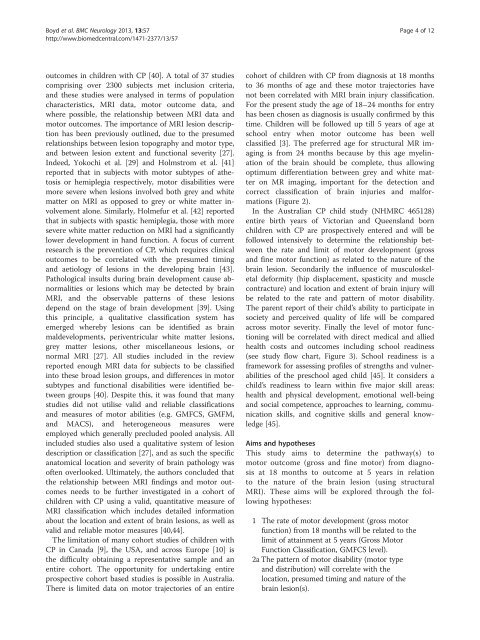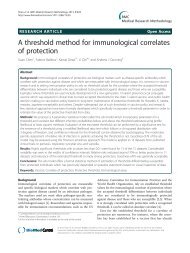Australian Cerebral Palsy Child Study: protocol of ... - BioMed Central
Australian Cerebral Palsy Child Study: protocol of ... - BioMed Central
Australian Cerebral Palsy Child Study: protocol of ... - BioMed Central
Create successful ePaper yourself
Turn your PDF publications into a flip-book with our unique Google optimized e-Paper software.
Boyd et al. BMC Neurology 2013, 13:57 Page 4 <strong>of</strong> 12<br />
http://www.biomedcentral.com/1471-2377/13/57<br />
outcomes in children with CP [40]. A total <strong>of</strong> 37 studies<br />
comprising over 2300 subjects met inclusion criteria,<br />
and these studies were analysed in terms <strong>of</strong> population<br />
characteristics, MRI data, motor outcome data, and<br />
where possible, the relationship between MRI data and<br />
motor outcomes. The importance <strong>of</strong> MRI lesion description<br />
has been previously outlined, due to the presumed<br />
relationships between lesion topography and motor type,<br />
and between lesion extent and functional severity [27].<br />
Indeed, Yokochi et al. [29] and Holmstrom et al. [41]<br />
reported that in subjects with motor subtypes <strong>of</strong> athetosis<br />
or hemiplegia respectively, motor disabilities were<br />
more severe when lesions involved both grey and white<br />
matter on MRI as opposed to grey or white matter involvement<br />
alone. Similarly, Holmefur et al. [42] reported<br />
that in subjects with spastic hemiplegia, those with more<br />
severe white matter reduction on MRI had a significantly<br />
lower development in hand function. A focus <strong>of</strong> current<br />
research is the prevention <strong>of</strong> CP, which requires clinical<br />
outcomes to be correlated with the presumed timing<br />
and aetiology <strong>of</strong> lesions in the developing brain [43].<br />
Pathological insults during brain development cause abnormalities<br />
or lesions which may be detected by brain<br />
MRI, and the observable patterns <strong>of</strong> these lesions<br />
depend on the stage <strong>of</strong> brain development [39]. Using<br />
this principle, a qualitative classification system has<br />
emerged whereby lesions can be identified as brain<br />
maldevelopments, periventricular white matter lesions,<br />
grey matter lesions, other miscellaneous lesions, or<br />
normal MRI [27]. All studies included in the review<br />
reported enough MRI data for subjects to be classified<br />
into these broad lesion groups, and differences in motor<br />
subtypes and functional disabilities were identified between<br />
groups [40]. Despite this, it was found that many<br />
studies did not utilise valid and reliable classifications<br />
and measures <strong>of</strong> motor abilities (e.g. GMFCS, GMFM,<br />
and MACS), and heterogeneous measures were<br />
employed which generally precluded pooled analysis. All<br />
included studies also used a qualitative system <strong>of</strong> lesion<br />
description or classification [27], and as such the specific<br />
anatomical location and severity <strong>of</strong> brain pathology was<br />
<strong>of</strong>ten overlooked. Ultimately, the authors concluded that<br />
the relationship between MRI findings and motor outcomes<br />
needs to be further investigated in a cohort <strong>of</strong><br />
children with CP using a valid, quantitative measure <strong>of</strong><br />
MRI classification which includes detailed information<br />
about the location and extent <strong>of</strong> brain lesions, as well as<br />
valid and reliable motor measures [40,44].<br />
The limitation <strong>of</strong> many cohort studies <strong>of</strong> children with<br />
CP in Canada [9], the USA, and across Europe [10] is<br />
the difficulty obtaining a representative sample and an<br />
entire cohort. The opportunity for undertaking entire<br />
prospective cohort based studies is possible in Australia.<br />
There is limited data on motor trajectories <strong>of</strong> an entire<br />
cohort <strong>of</strong> children with CP from diagnosis at 18 months<br />
to 36 months <strong>of</strong> age and these motor trajectories have<br />
not been correlated with MRI brain injury classification.<br />
For the present study the age <strong>of</strong> 18–24 months for entry<br />
has been chosen as diagnosis is usually confirmed by this<br />
time. <strong>Child</strong>ren will be followed up till 5 years <strong>of</strong> age at<br />
school entry when motor outcome has been well<br />
classified [3]. The preferred age for structural MR imaging<br />
is from 24 months because by this age myelination<br />
<strong>of</strong> the brain should be complete, thus allowing<br />
optimum differentiation between grey and white matter<br />
on MR imaging, important for the detection and<br />
correct classification <strong>of</strong> brain injuries and malformations<br />
(Figure 2).<br />
In the <strong>Australian</strong> CP child study (NHMRC 465128)<br />
entire birth years <strong>of</strong> Victorian and Queensland born<br />
children with CP are prospectively entered and will be<br />
followed intensively to determine the relationship between<br />
the rate and limit <strong>of</strong> motor development (gross<br />
and fine motor function) as related to the nature <strong>of</strong> the<br />
brain lesion. Secondarily the influence <strong>of</strong> musculoskeletal<br />
deformity (hip displacement, spasticity and muscle<br />
contracture) and location and extent <strong>of</strong> brain injury will<br />
be related to the rate and pattern <strong>of</strong> motor disability.<br />
The parent report <strong>of</strong> their child’s ability to participate in<br />
society and perceived quality <strong>of</strong> life will be compared<br />
across motor severity. Finally the level <strong>of</strong> motor functioning<br />
will be correlated with direct medical and allied<br />
health costs and outcomes including school readiness<br />
(see study flow chart, Figure 3). School readiness is a<br />
framework for assessing pr<strong>of</strong>iles <strong>of</strong> strengths and vulnerabilities<br />
<strong>of</strong> the preschool aged child [45]. It considers a<br />
child’s readiness to learn within five major skill areas:<br />
health and physical development, emotional well-being<br />
and social competence, approaches to learning, communication<br />
skills, and cognitive skills and general knowledge<br />
[45].<br />
Aims and hypotheses<br />
This study aims to determine the pathway(s) to<br />
motor outcome (gross and fine motor) from diagnosis<br />
at 18 months to outcome at 5 years in relation<br />
to the nature <strong>of</strong> the brain lesion (using structural<br />
MRI). These aims will be explored through the following<br />
hypotheses:<br />
1 The rate <strong>of</strong> motor development (gross motor<br />
function) from 18 months will be related to the<br />
limit <strong>of</strong> attainment at 5 years (Gross Motor<br />
Function Classification, GMFCS level).<br />
2a The pattern <strong>of</strong> motor disability (motor type<br />
and distribution) will correlate with the<br />
location, presumed timing and nature <strong>of</strong> the<br />
brain lesion(s).
















